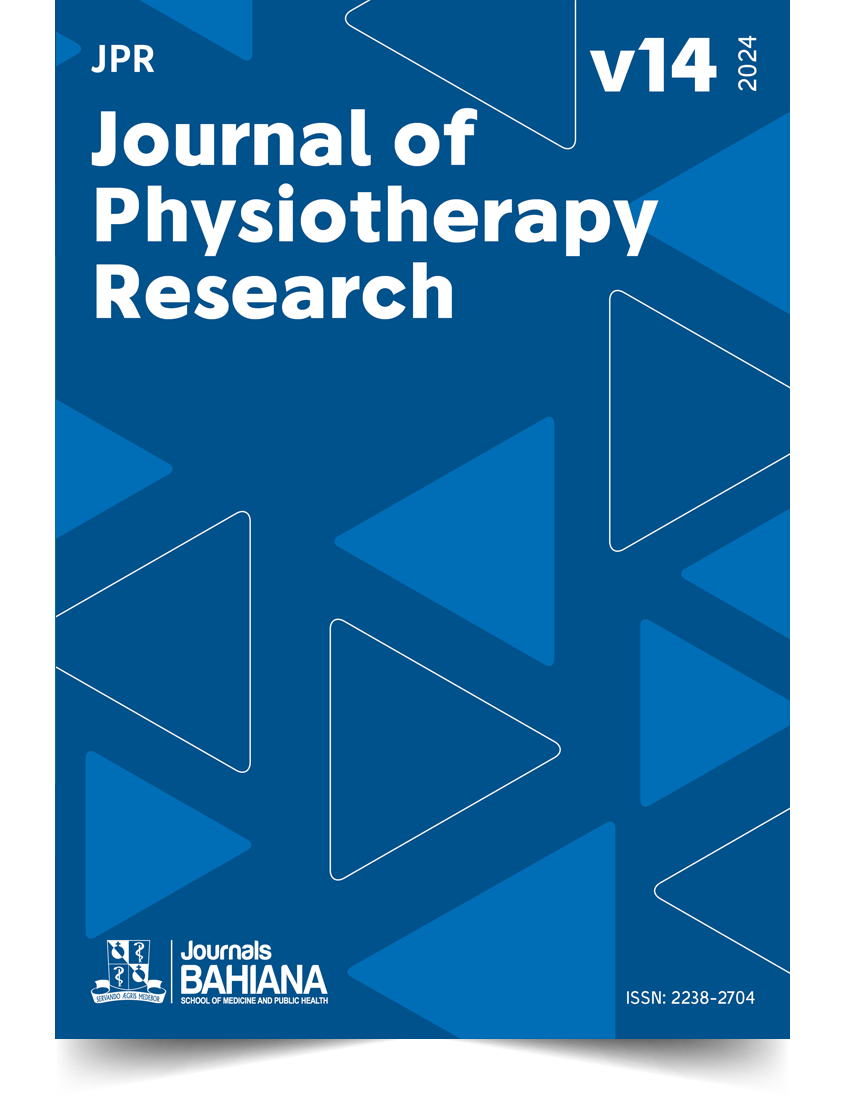Influence of the use of a walking diary on mobility in patients in cardiac rehabilitation phase 1: a randomized clinical trial
DOI:
https://doi.org/10.17267/2238-2704rpf.2024.e5664Keywords:
Cardiac Rehabilitation, Walking, MobilizationAbstract
INTRODUCTION: Inpatient rehabilitation is extremely important for patients recovering from cardiac surgery. Although a walking diary is routinely used in clinical practice, it has yet to be adequately tested and reported in the literature. OBJECTIVES: To establish whether the use of a walking diary affects the number of steps taken following cardiac surgery and whether this is related to the patient’s level of cardiac anxiety. METHODS: An open, controlled, randomized clinical trial was conducted with adult patients submitted to elective valve and/or coronary surgery, who had no motor impairment. All the participants used a pedometer to register the number of steps taken over five consecutive days in the hospital. Twenty-nine individuals were randomized to create an intervention group that used the walking diary as a treatment strategy, while twenty-three were allocated to a control group. The Mann-Whitney test was used to compare the number of steps between the two groups, while Spearman’s correlation coefficient was performed to evaluate the relationship between the number of steps and the level of cardiac anxiety. Statistical significance was defined as p<0.05. RESULTS: The groups were similar regarding their demographic, clinical and surgical characteristics. There was no difference between the groups regarding the total number of steps taken: control group=1,496 (477.5 - 2992.5) vs. intervention group=1,468.5 (494.2 - 2,678) (p=0.902). CONCLUSION: The use of the walking diary had no effect on the number of steps taken and was unassociated with the level of cardiac anxiety in inpatients following cardiac surgery.
Downloads
References
(1) Jessup RL, Buchbinder R. What if I cannot choose wisely? Addressing suboptimal health literacy in our patients to reduce over-diagnosis and overtreatment. Intern Med J. 2018;48(9):1154–7. https://doi.org/10.1111/imj.14025
(2) Cordeiro ALL, Queiroz GO, Souza MM, Guimarães AR, Araújo TM, Correia Junior MAV, et al. Tempo de ventilação mecânica e força muscular periférica na pós-cirurgia cardíaca. Int J Cardiovasc Sci. 2016;29(2):134–8. Disponível em: https://pesquisa.bvsalud.org/portal/resource/pt/biblio-831104
(3) Morais DB, Lopes ACR, Sá VM, Silva Júnior WM, Cerqueira Neto ML. Evaluation of functional performance in patients undergoing cardiac surgery. Rev Bras Cardiol. 2010;23(5):263–9. Available from: https://pesquisa.bvsalud.org/portal/resource/pt/lil-568754
(4) Costa Junior JMF, Almeida KS, Santos MCS, Carneiro SR, Torres DC. Pedometer evaluation in patients in post-operative surgery coronary artery bypass grafting after early mobilization in bed intensive care unit. Rev Para Med. 2015;29(2):45–50. http://dx.doi.org/10.13140/RG.2.2.31924.71045
(5) Papaspyros S, Uppal S, Khan SA, Paul S, O’Regan DJ. Analysis of bedside entertainment services’ effect on post cardiac surgery physical activity: a prospective, randomised clinical trial. Eur J Cardiothoracic Surg. 2008;34(5):1022–6. https://doi.org/10.1016/j.ejcts.2008.05.042
(6) Mungovan S, Singh P, Gass G, Smart N, Hirschhorn A. Effect of physical activity in the first five days after cardiac surgery. J Rehabil Med. 2017;49(1):71–7. https://doi.org/10.2340/16501977-2165
(7) Takahashi T, Kumamaru M, Jenkins S, Saitoh M, Morisawa T, Matsuda H. In-patient step count predicts re-hospitalization after cardiac surgery. J Cardiol. 2015;66(4):286–91. https://doi.org/10.1016/j.jjcc.2015.01.006
(8) Heizmann AN, Chapelle C, Laporte S, Roche F, Hupin D, Le Hello C. Impact of wearable device-based interventions with feedback for increasing daily walking activity and physical capacities in cardiovascular patients: a systematic review and meta-analysis of randomised controlled trials. BMJ Open. 2023;13(7):e069966. https://doi.org/10.1136%2Fbmjopen-2022-069966
(9) Lee PH, Macfarlane DJ, Lam T, Stewart SM. Validity of the international physical activity questionnaire short form (IPAQ-SF): A systematic review. Int J Behav Nutr Phys Act. 2011;8(115):1-11. https://doi.org/10.1186/1479-5868-8-115
(10) Sardinha A, Nardi AE, Araújo CGS, Ferreira MC, Eifert GH. Brazilian Portuguese Validated Version of the Cardiac Anxiety Questionnaire. Arq Bras Cardiol. 2013;101(6):554-61. https://doi.org/10.5935/abc.20130207
(11) Lordello GGG, Gama GGG, Rosier GL, Viana PADC, Correia LC, Ritt LEF. Effects of cycle ergometer use in early mobilization following cardiac surgery: a randomized controlled trial. Clinical Rehabilitation. 2020;34(4):450–459. https://doi.org/10.1177/0269215520901763
(12) Rosier GL, Lordello GGG, Moura MA, Correia LS, Polte LLS, Gardenghi G, et al. Mobility after Heart Surgery: What Are Influential Factors? J Pharm Pharmacol. 2018;6(4):429-35. http://dx.doi.org/10.17265/2328-2150/2018.04.016
(13) Izawa KP, Watanabe S, Hiraki K, Morio Y, Kasahara Y, Takeichi N, et al. Determination of the effectiveness of accelerometer use in the promotion of physical activity in cardiac patients: A randomized controlled trial. Arch Phys Med Rehabil. 2012;93(11):1896–902. https://doi.org/10.1016/j.apmr.2012.06.015
(14) Hirschhorn AD, Richards D, Mungovan SF, Morris NR, Adams L. Supervised Moderate Intensity Exercise Improves Distance Walked at Hospital Discharge Following Coronary Artery Bypass Graft Surgery-A Randomised Controlled Trial. Heart Lung Circ. 2008;17(2):129–38. https://doi.org/10.1016/j.hlc.2007.09.004
(15) Sallis R, Roddy-Sturm Y, Chijioke E, Litman K, Kanter MH, Huang BZ, et al. Stepping toward discharge: Level of ambulation in hospitalized patients. J Hosp Med. 2015;10(6):384–9. https://doi.org/10.1002/jhm.2343
(16) Eser P, Gonzalez-Jaramillo N, Weber S, Fritsche J, Femiano R, Werner C, et al. Objectively measured adherence to physical activity among patients with coronary artery disease: Comparison of the 2010 and 2020 World Health Organization guidelines and daily steps. Front Cardiovasc Med. 2022;28(9):951042. https://doi.org/10.3389%2Ffcvm.2022.951042
(17) Vasavi VL, Khandekar J, Singh VP, Samuel SR, D’Souza MC. Effectiveness of pedometer-based exercise program in phase 1 and phase 2 cardiac rehabilitation: A Systematic Review [version 1; peer review: 2 not approved]. F1000Research. 2022;11:451 https://doi.org/10.12688/f1000research.109941.1
(18) Whyte J, Dijkers MP, Hart T, Van Stan JH, Packel A, Turkstra LS, et al. The Importance of Voluntary Behavior in Rehabilitation Treatment and Outcomes. Arch Phys Med Rehabil. 2018;100(1):156-63. https://doi.org/10.1016/j.apmr.2018.09.111
(19) Hart T, Dijkers MP, Whyte J, Turkstra LS, Zanca JM, Packel A, et al. A Theory-Driven System for the Specification of Rehabilitation Treatments. Arch Phys Med Rehabil. 2019;100(1):172–80. https://doi.org/10.1016/j.apmr.2018.09.109
Downloads
Published
Issue
Section
License
Copyright (c) 2024 Gabriela Lago Rosier, Gleide Glícia Gama Lordello, Patrícia Alcântara Doval de Carvalho Viana, Luiz Eduardo Fonteles Ritt, Gilson Soares Feitosa Filho

This work is licensed under a Creative Commons Attribution 4.0 International License.
This work is licensed under a Creative Commons Attribution 4.0 International License.



